
by Christian Buil
The Solar Explorer - May 20 2025

by Christian Buil
The Solar Explorer - May 20 2025
Summary:
1 - Constitution of Sol'Ex
2 - Optics
2.1 - Slit
2.2 - Lenses
2.3 - Grating
3 - Mechanics
4 - Accessories
5 - Software
6 - Video channels, discussion lists, forum
Part 1: Constitution of Sol’Ex
Sol'Ex is an observation instrument consisting of optical components, a mechanical structure, and a few accessories, such as an inexpensive planetary camera for recording images of the Sun.
All optical components are available as a kit from Shelyak Instruments, a partner in the Sol'Ex project.
The following view shows the components of the Shelyak Instruments optical kit:
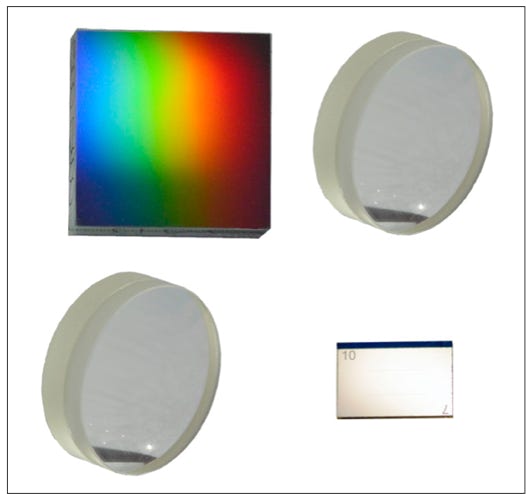
The mechanical structure of Sol'Ex is based on 3D printing technology, which offers numerous advantages: lightness, modularity, good mechanical performance, and low cost.
A complete mechanical kit can be ordered from Asur3DPrint, the official partner of the Sol'Ex project. This kit is delivered pre-assembled, with metal inserts, standard screws (ISO), and several additional accessories to facilitate assembly and use of the instrument.
Azur3DPrint offers, upon request, the original version of the Sol'Ex kit, known as “historic” or V1, as well as more recent versions that remain faithful to the initial concept while incorporating numerous improvements. These improvements concern the ease of adjustment, the mechanical rigidity of the assembly, and the overall aesthetics of the instrument. These models are designated V2 and V2 Pro.
The figure below shows the appearance of Sol'Ex assembled from a V2 kit supplied by Azur3DPrint:
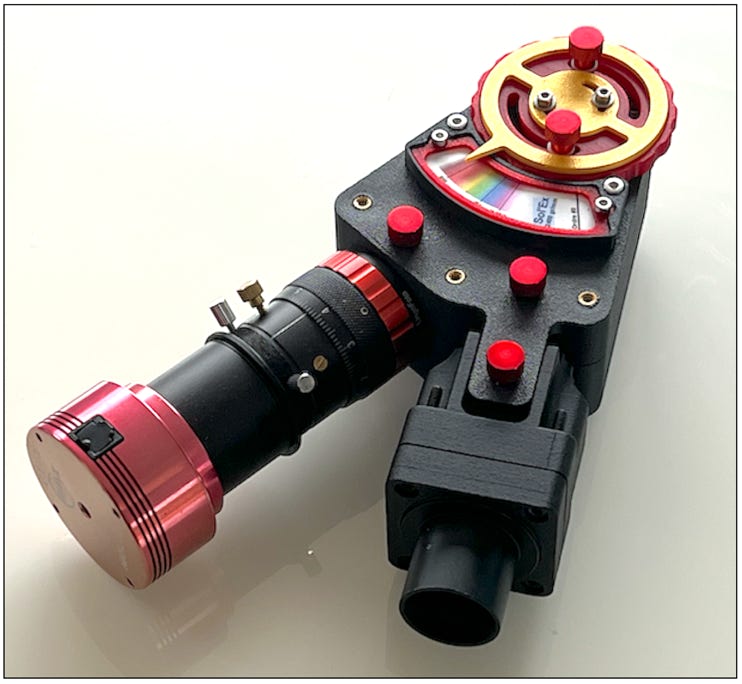
Please note that you can always print the historical version of Sol'Ex yourself, as the STL files are freely available (see below). You will also find various versions of the project online. However, only those marked “Sol'Ex by xxx” are recognized and endorsed by the project's authors.
Additional accessories mainly consist of a standard focusing system and a CMOS camera (we will return to the recommended models later). These items are available from most specialist astronomy retailers.
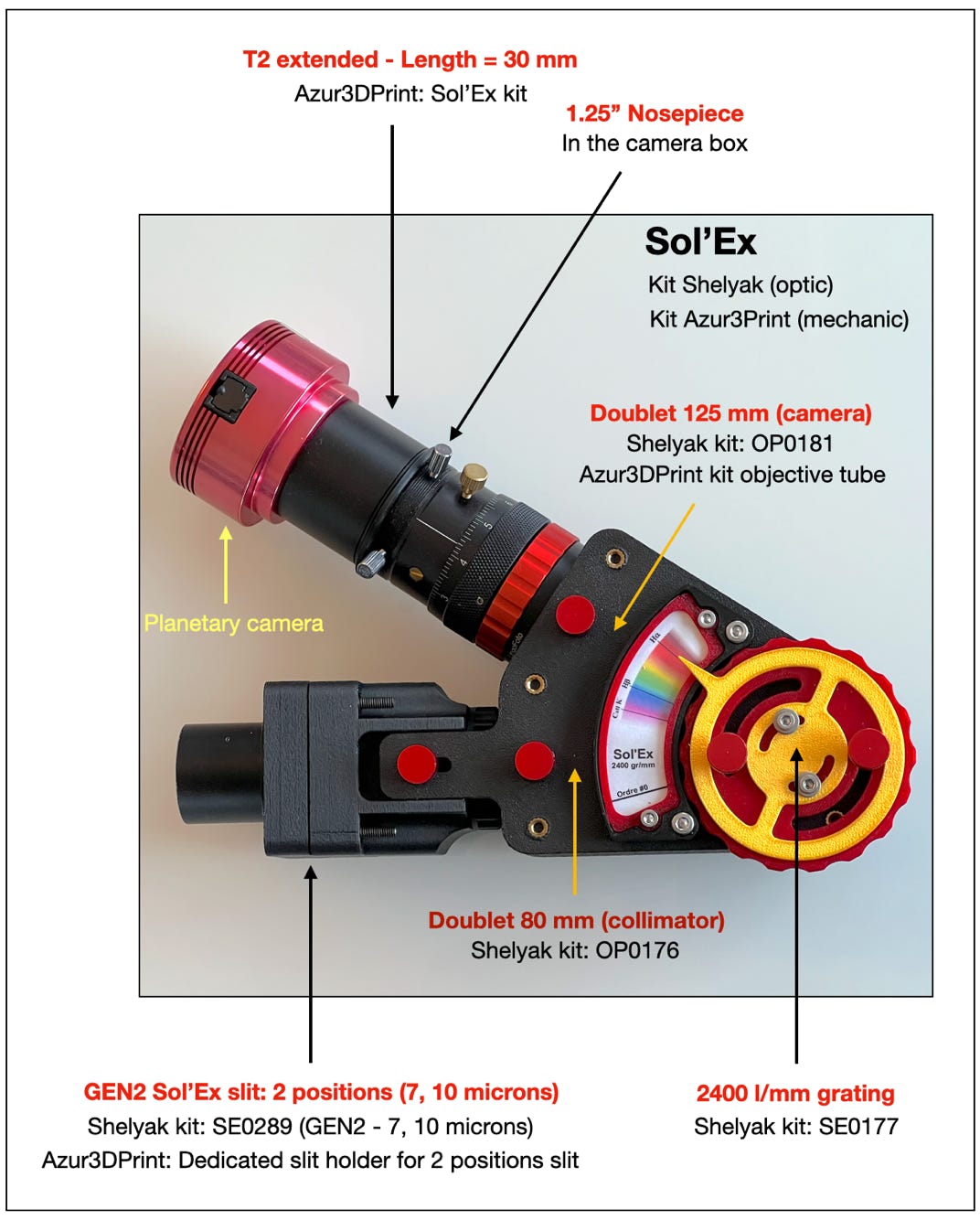
You will also need software to control the camera and another program to process the data acquired. In both cases, there are powerful solutions available free of charge. In particular, the INTI software developed by Valérie Desnoux allows for automated and efficient processing of your observations.
Let's take a closer look at all of this.
Part 2: Optic
As explained on the “Theory” page of this documentation, the Sol'Ex instrument requires four components to function. In order:
⁃ A narrow slit onto which a clear image of the Sun is projected using your telescope. The function of this slit is to set the spectral resolution of the instrument.
⁃ A collimating lens, whose function is to make the light rays coming from a given point on the narrow entrance slit parallel in the diffraction grating space.
⁃ The diffraction grating, which, like a glass prism, disperses the spectrum into different angles (the angles at which the rays exit this component depend on their wavelength).
⁃ An objective lens that forms a clear image of the spectrum in the plane of an electronic detector (that of your camera).
2.1 - The slit
The latest version of the Sol'Ex slit, included in the kit offered by Shelyak Instruments, is the GEN2 model. It consists of a double slit engraved in a thin layer of chrome deposited on one side of a 2 mm thick, 12 mm × 8 mm parallel-sided blade. The other side is anti-reflective.
This component has two slits of different widths: one 10 microns wide and the other 7 microns wide. For common applications, the 10-micron slit is preferred, as it is more suitable for most situations. Both slits are 6 mm long, but in practice, given the optical characteristics of Sol'Ex, only 4.5 mm are usable.
For more information on this Sol'Ex GEN2 slit, including cleaning recommendations in the event of an incident, please refer to the following document:
https://buil.astrosurf.com/starex/slit_solex_gen2.pdf
Please note: the slit supplied by Shelyak is a very high-quality, specially manufactured component, which is essential for ensuring the comfort of use and overall performance of Sol'Ex.
2.2 - Lenses
The lenses used are achromatic doublets with magnesium fluoride (MgF₂) anti-reflective coating on the outer surfaces.
The collimating lens has a focal length of 80 mm and a diameter of approximately 25 mm. This lens is common to all observation configurations: whether you use Sol'Ex for solar observation or Star'Ex for deep sky spectral analysis. This approach streamlines investment and simplifies the optical configuration: once this lens is mounted and correctly adjusted, it is normally no longer necessary to touch it, whether you switch from Sol'Ex to Star'Ex or vice versa.
The objective lens has a focal length of 125 mm and a diameter of approximately 25 mm.
The objectives included in the Sol'Ex optical kit from Shelyak Instruments are specifically manufactured for this instrument. However, it is possible to purchase equivalent components offering comparable performance from ThorLabs under the following references:
• Collimator lens: AC254-080-A
• Camera lens: AC254-125-A
As shown in the spot diagrams below, the size of the image spots is very similar between the lenses supplied by Shelyak and those from Thorlabs, both for a field angle of 0° (center of the solar disk) and for a field angle of 0.26° (solar limb), when Sol'Ex is mounted on a SkyWatcher EVOSTAR 72ED telescope used at full aperture:

2.3 - Grating
The diffraction grating used in Sol'Ex is a 25 mm x 25 mm component with a thickness of 6 mm. It is holographic, with a density of 2400 lines/mm and optimized for the visible part of the spectrum.
You can purchase this grating separately from the Shelyak Instruments kit from ThorLabs under the reference: GH25-24V.
Part 3: Mechanic
The mechanical design of Sol'Ex is based primarily on 3D printing.
The CAD design of the original version was created using OpenScad software, ensuring that the number of parts was limited and that they were very easy to print yourself.
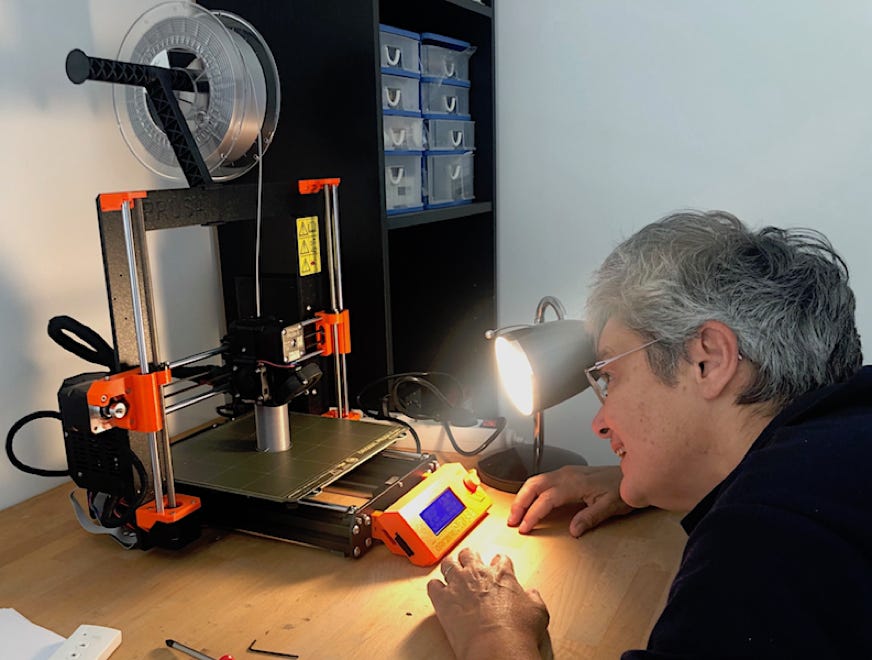
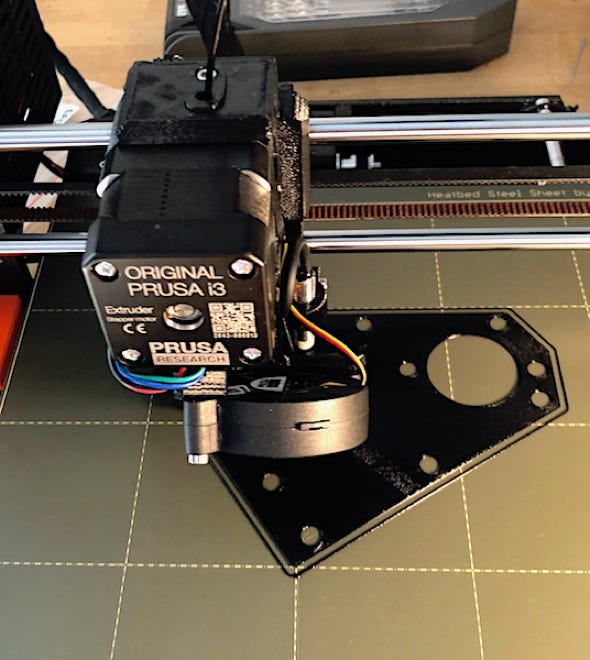
Many Sol'Ex models are printed using PETG filament, a material that offers excellent mechanical and thermal stability and is ideal for this application. However, it is essential to use black filament, which is opaque not only to visible light but also to near-infrared light (invisible to the human eye). This choice is crucial to prevent stray light from entering, which could alter the contrast of the solar images obtained. Black filaments from REAL or SUNLU, for example, have given excellent results—but these are just a few examples among many.
Some users choose to print Sol'Ex with carbon-filled PETG to increase structural rigidity. This approach is entirely appropriate, but it should be noted that it requires the use of a special hardened steel nozzle due to the abrasiveness of the filament, as well as a longer printing time. There is also a wide range of technical filaments that offer remarkable performance in terms of rigidity and thermal stability—this is particularly true of the material used in the V2 Pro version offered by Azur3DPrint.
All STL files for the original version (historical V1) of Sol'Ex are grouped together in a ZIP archive: stl_solex_v2. An overview of the parts that make up this version is presented below:
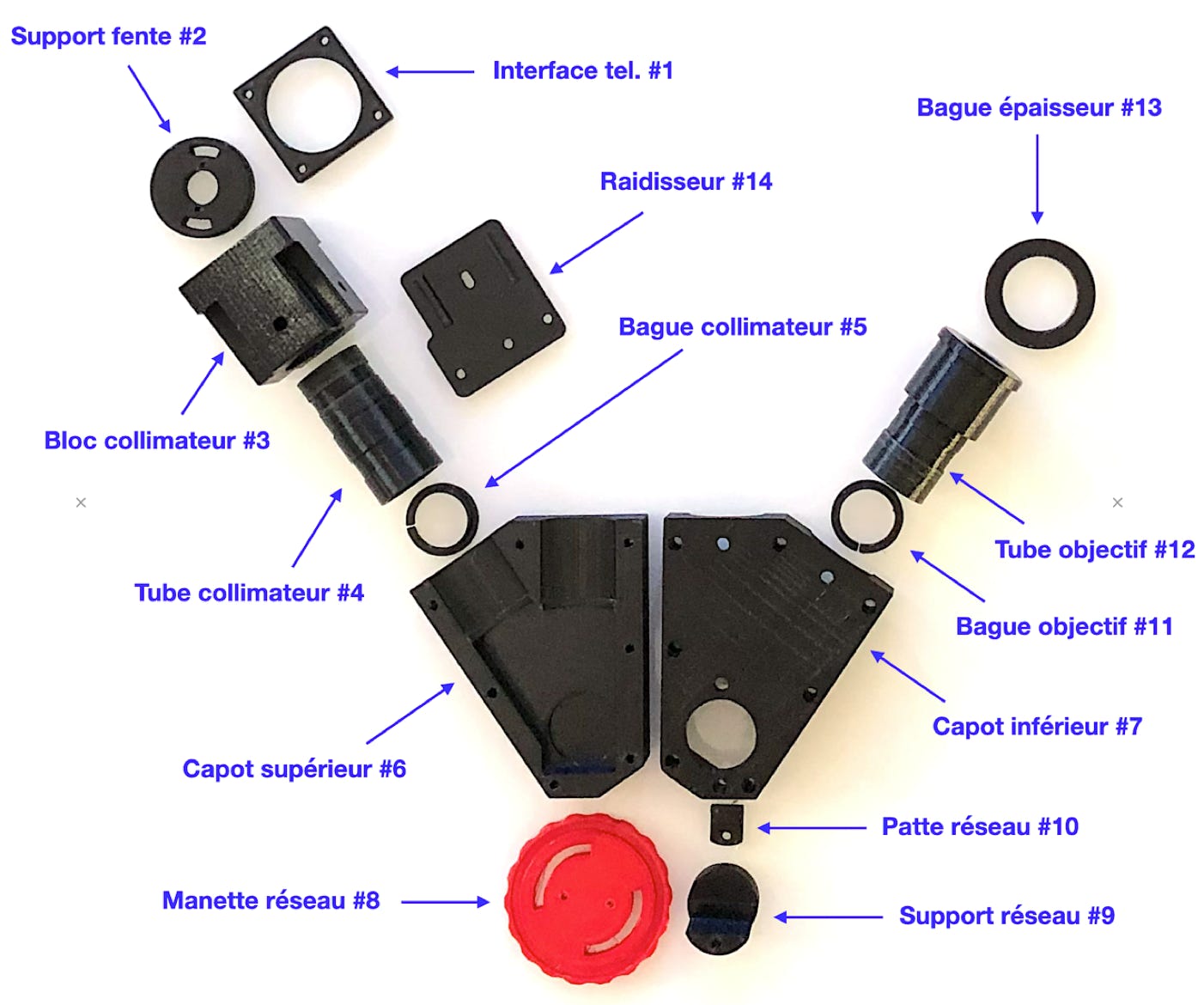
If you are starting out on your own, keep in mind that most parts are made with a 15% or 20% “gyroid” infill, 0.2 mm precision, and 2 layers for the walls. Exceptions are:
• Collimator and camera tubes are recommended to be printed with 3 or 4 layers.
• Threaded parts must be printed locally with an accuracy of 0.15 mm.
The collimator block requires supports to be printed (this is the only part in the set).
The initial Sol'Ex components being assembled and the finished result:
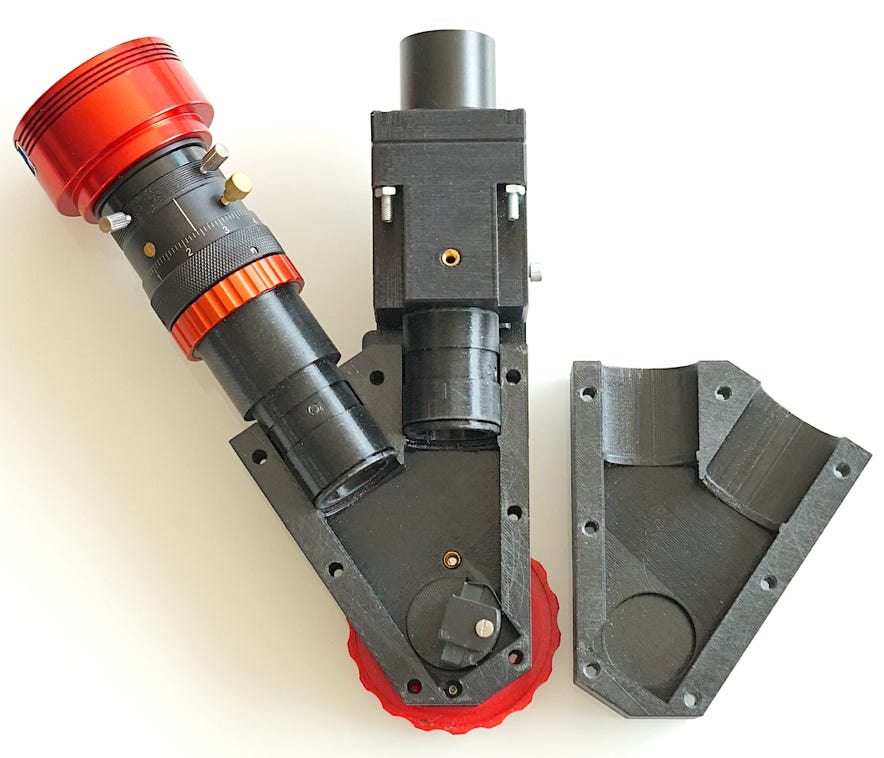
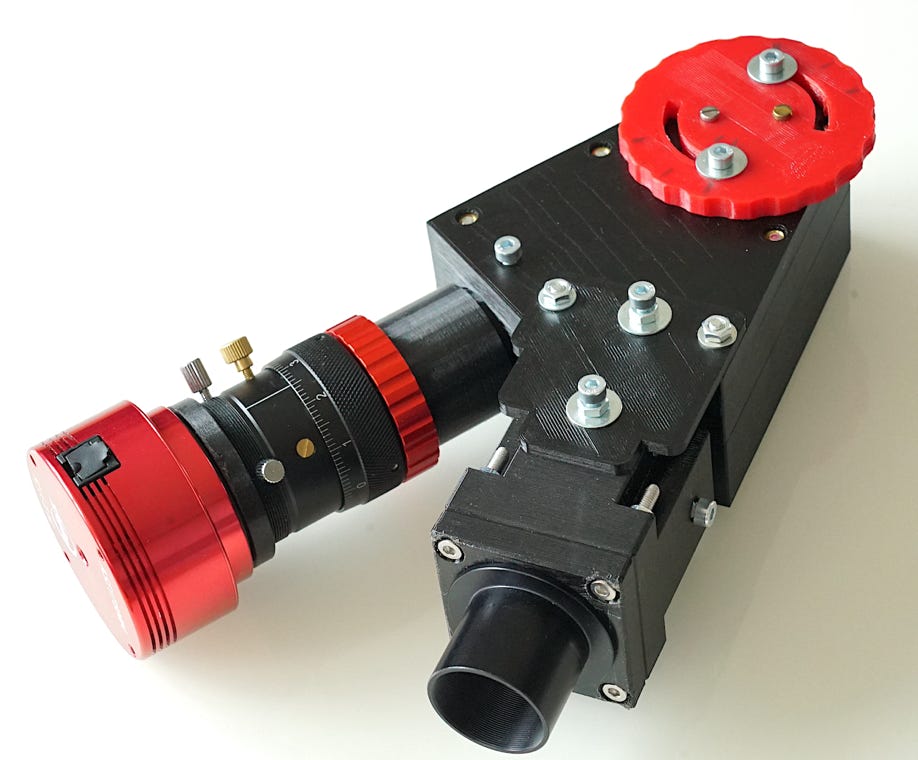
If you don't have a 3D printer, or if you want a very neat, pre-assembled, and easy-to-adjust version, remember that you can always contact Azur3DPrint.
This company offers a complete ready-to-use kit, as well as a whole ecosystem of accessories for Sol'Ex: filter holders, various interfaces, and of course, the option to upgrade to the Star'Ex instrument with ease.
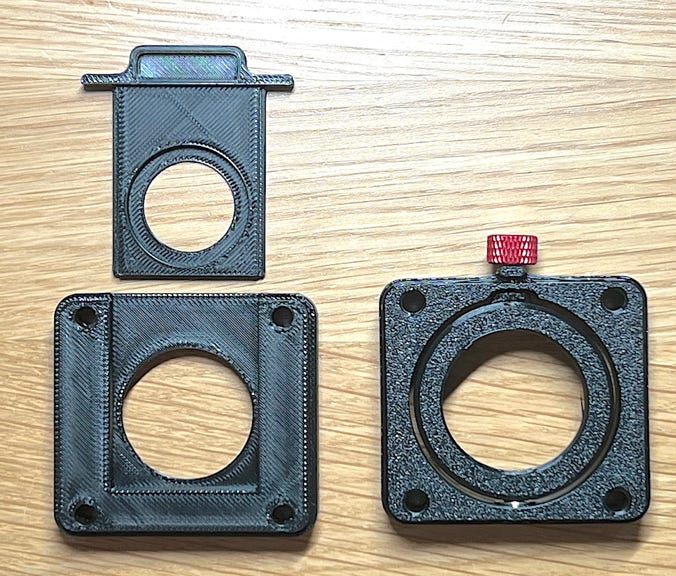
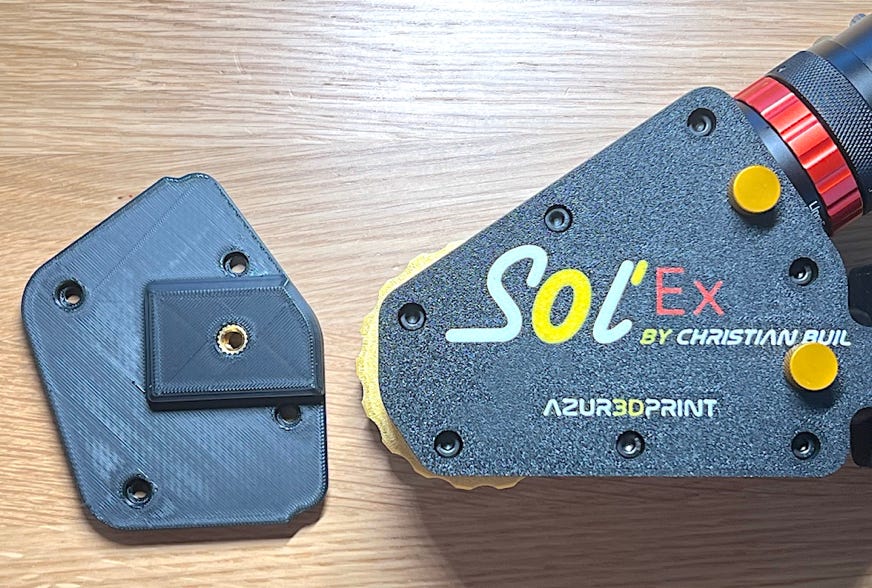
Below is a Sol'Ex in Azur3DPrint printed V2 version in operation on an Askar FRA300 scope:
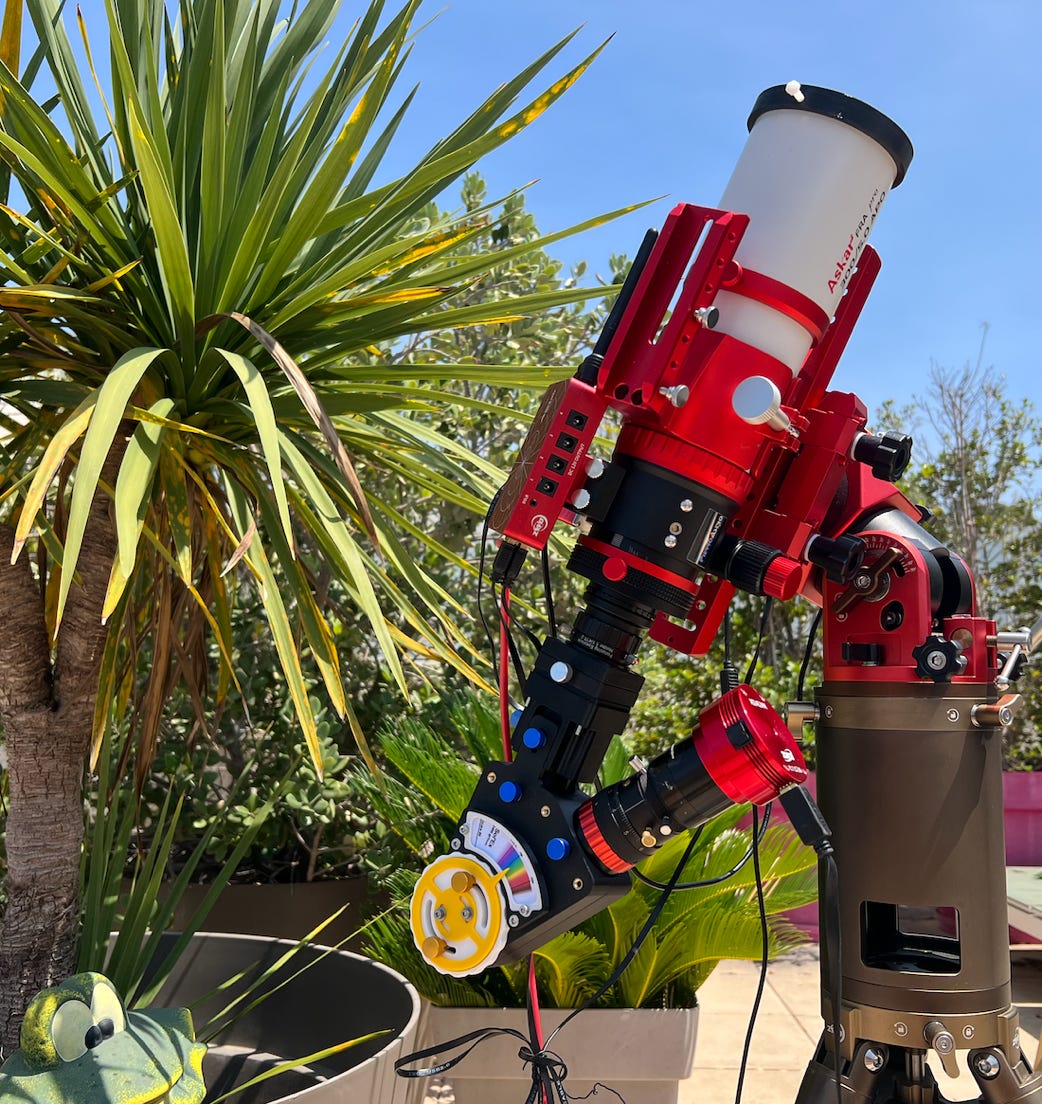
Part 4: Accessories
In addition to the 3D-printed elements and optical components described above, a helical focusing system must be added. This allows for precise and convenient adjustment of the spectrum focus in the camera detector plane.
The models offered by SVBony and ZWO are perfectly suited for this application.
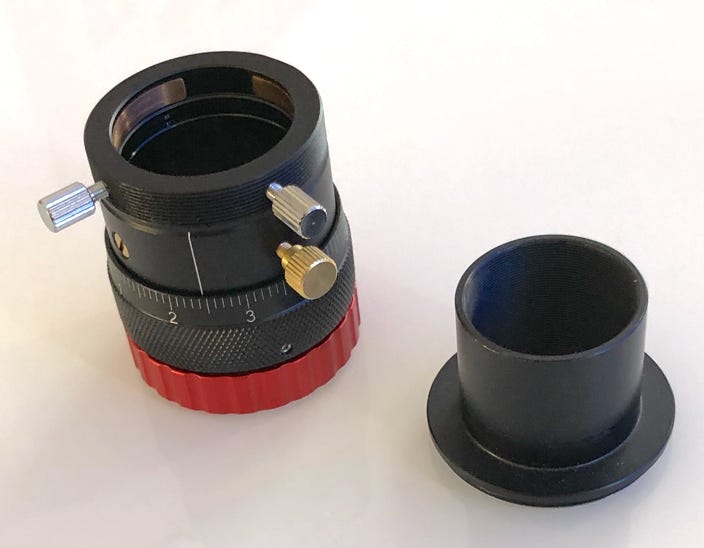
When it comes to cameras, there is a wide range of options available, and this range is constantly evolving: models quickly become obsolete as technology advances. At the time of writing, one of the best sensors for use with Sol'Ex is the Sony IMX585 (note: this sensor is not manufactured by Kodak, but by Sony).
Ideally, you should opt for a monochrome sensor with small pixels, typically less than 3 microns. This optimizes both spectral resolution and sampling. However, it is important to note that any type of camera is suitable for beginners. A color camera, although slightly less efficient due to the Bayer matrix, is perfectly usable: there is no need to invest in a dedicated model right away.
Sol'Ex's camera interface has been designed to be universal, allowing compatibility with a wide variety of models. The example below illustrates the use of a SEDNA-M camera from Player One.
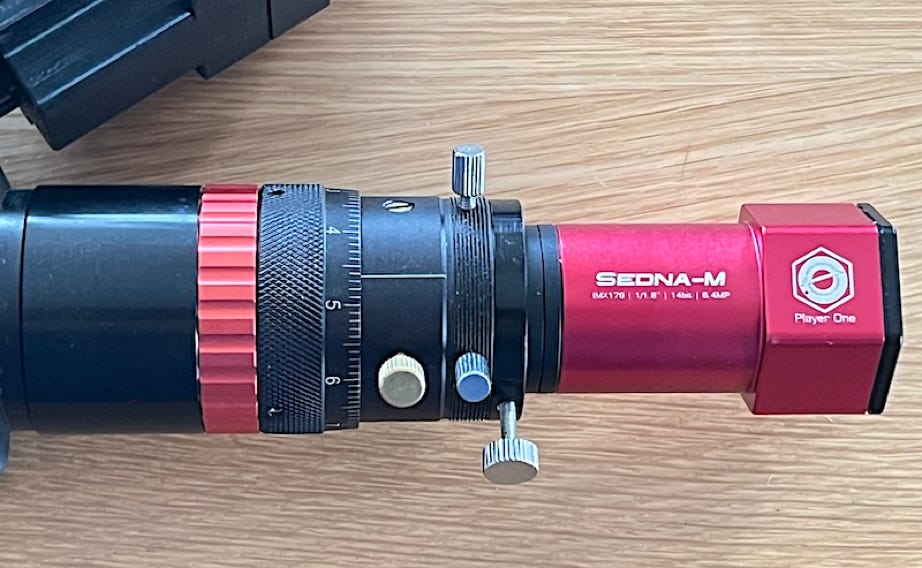
The choice of camera may also depend on whether the objective is to capture the entire solar disk in a single pass (a single “scan”), without truncation. The alternative is to reconstruct the complete image of the Sun after the fact by assembling several strips, a more tedious method but one that can result in a more detailed image.
For a single-shot capture, the focal length of the telescope used depends on both the size of the camera sensor and the effective slit length, which is limited to 4.5 mm in the case of Sol'Ex. Due to the optimal orientation of the sensor (the long side of the detector is aligned with the movement of the spectrum to maximize readout speed), it is this larger dimension that must be taken into account—an advantage when using rectangular sensors.
However, even with a wide sensor, the maximum focal length for capturing the entire solar disk is fundamentally limited by the height of the Sol'Ex entrance slit, which is 4.5 mm in practice. This dimension sets the maximum observable angular field, which should be compared to the apparent diameter of the Sun, which is approximately 0.5°.
For more information on this point, refer to the Theory section of this documentation.
Below are some common configurations combining cameras and glasses, with the maximum focal lengths allowing the entire solar disk to be captured in a single pass:
The example of an ASI178MM camera
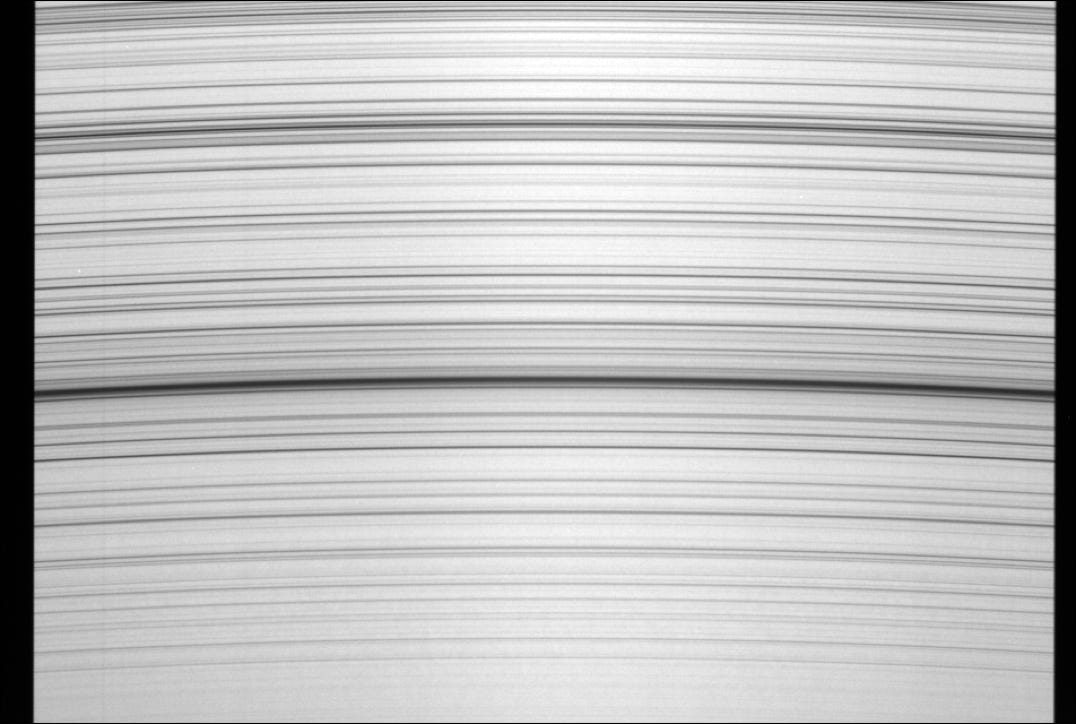

Image size: 3896 pixels x 2080 pixels - Pixel size: 2.4 microns
Spectral sampling (blnning 1x1): 0.0626 A/pixel
Maximum telescope focal length to observe the entire solar disk in one pass: 480 mm (limited by slit width).
The example of an ASI290 Mini or ASI462MM
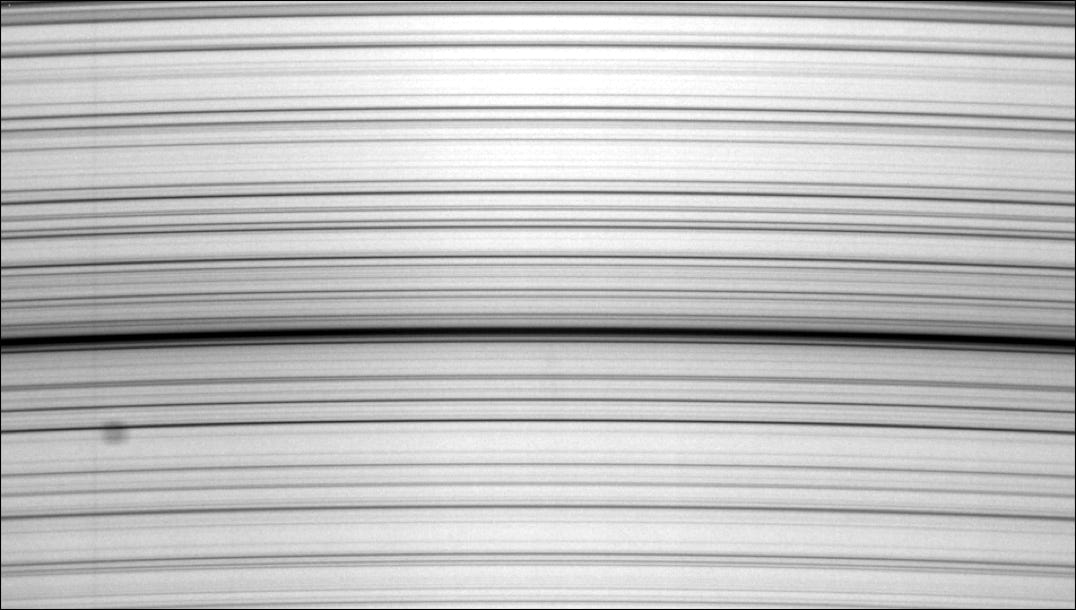
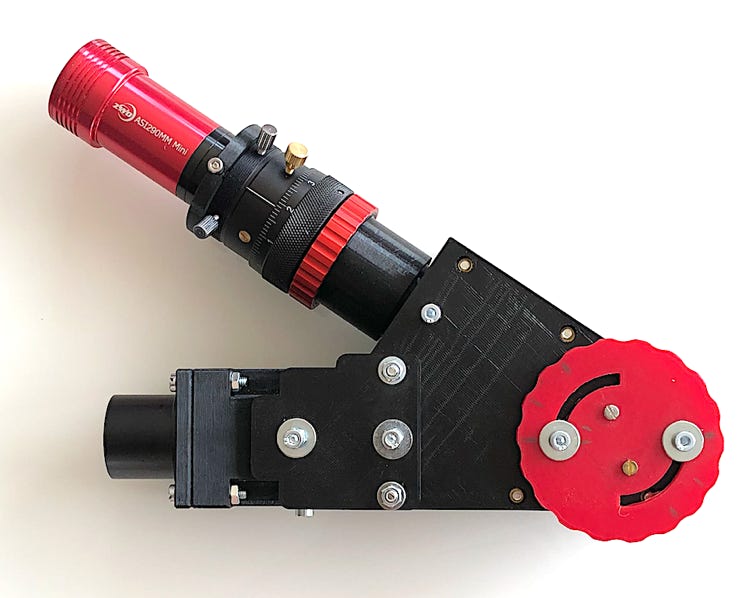
Image size: 1936 pixels x 1096 pixels - Pixel size: 2.9 microns
Spectral sampling (blnning 1x1): 0.0756 A/pixel
Maximum telescope focal length to observe the entire solar disk in one pass: 380 mm (limited by sensor width).
Note: the use of miniature stick cameras may require 3D machining of an extension tube to focus the spectrum. Here's the STL file for such an extended tube (the thread is M28.5 x 0.5): tube_allonge_m28.stl.
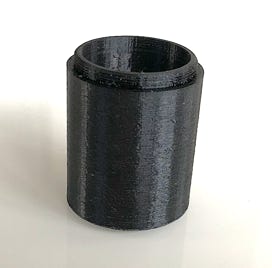
The example of an ASI174 mini camera
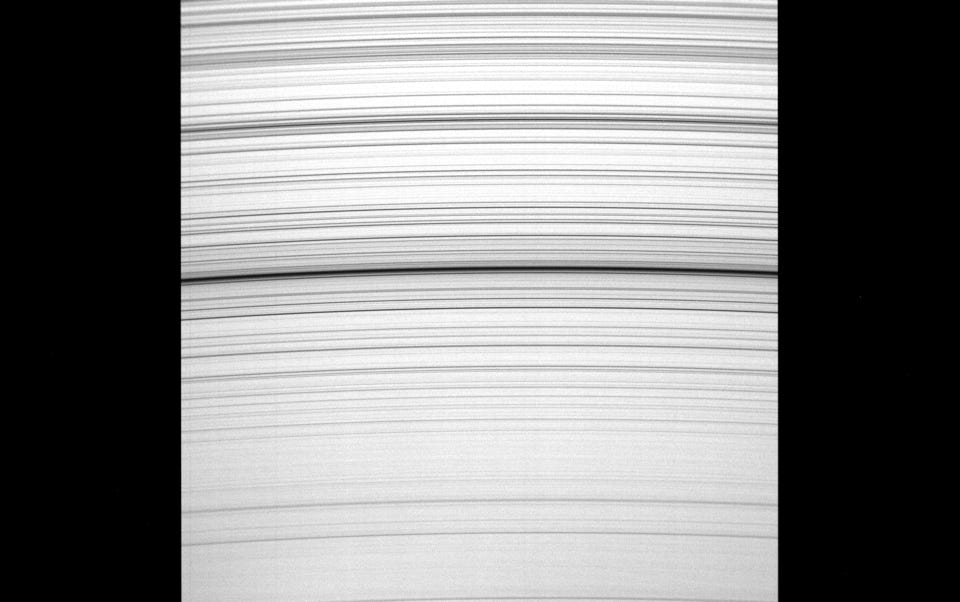

Image size: 1936 pixels x 1216 pixels - Pixel size: 5.86 microns
Spectral sampling (in 1x1 blnning): 0.1450 A/pixel
Maximum telescope focal length to observe the entire solar disk in one pass: 480 mm (limited by sensor width).
The example of an ASI183MM Pro camera
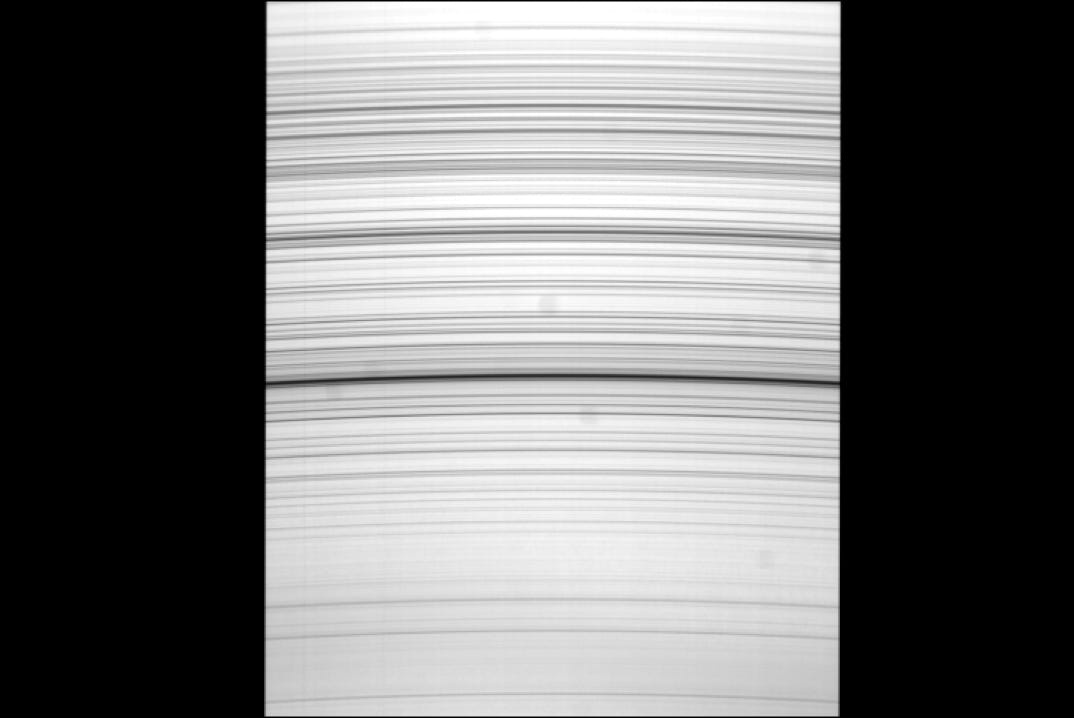
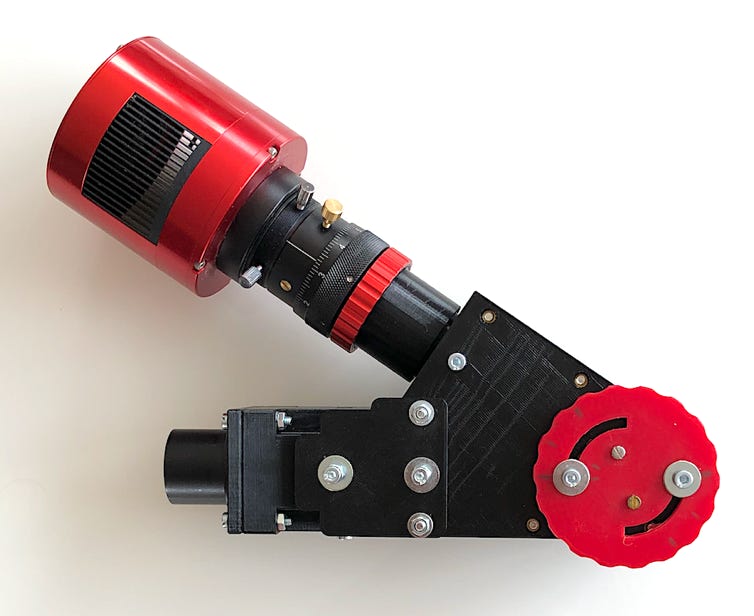
Image size: 5496 pixels x 3672 pixels - Pixel size: 2.4 microns
Spectral sampling (in 1x1 blnning): 0.0626 A/pixel
Maximum telescope focal length to observe the entire solar disk in one pass: 480 mm (limited by the slit width).
Finally, we'd like to mention the possibility of using a camera with Sol'Ex. Not a priori to acquire successive views enabling reconstruction of the solar disk, but for its undeniable interest in teaching spectrography to a less informed public (color image of the spectrum, display on a large screen via an HDMI socket, familiar and autonomous device...). Let's take the Sony A7s APN as an example (a T2 adapter to Sony NEX type "E" mount is required). In this case, with the "V1 mechanical version" of Sol'Ex, the historic Sol'Ex, a special lens tube has to be made. Click here for the corresponding STL file: kit_APN. With the "Azur3DPrint V2 mechanical version", the necessary interface is already included in the kit supplied.
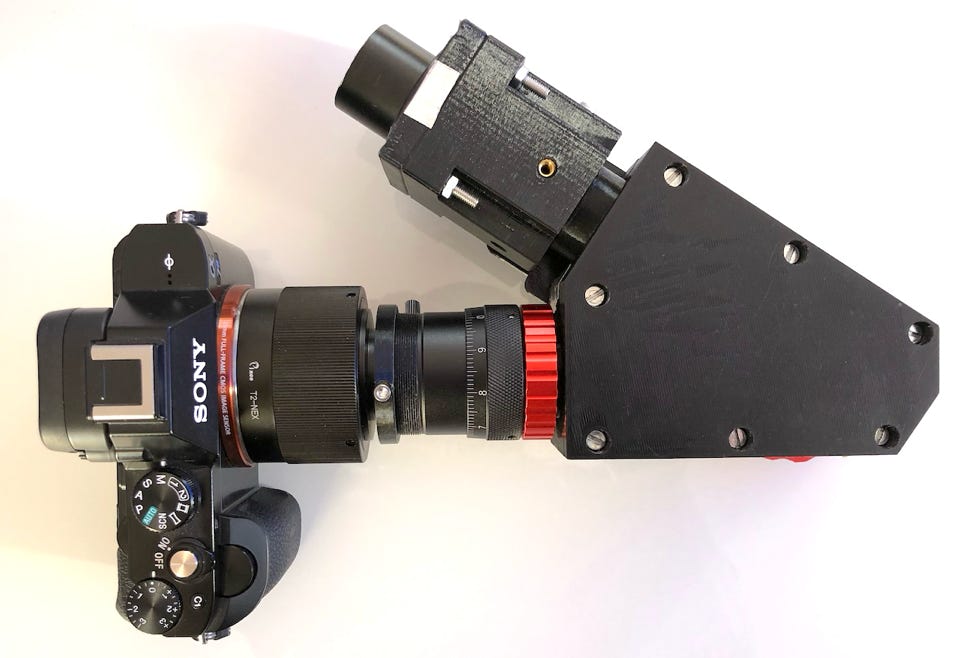
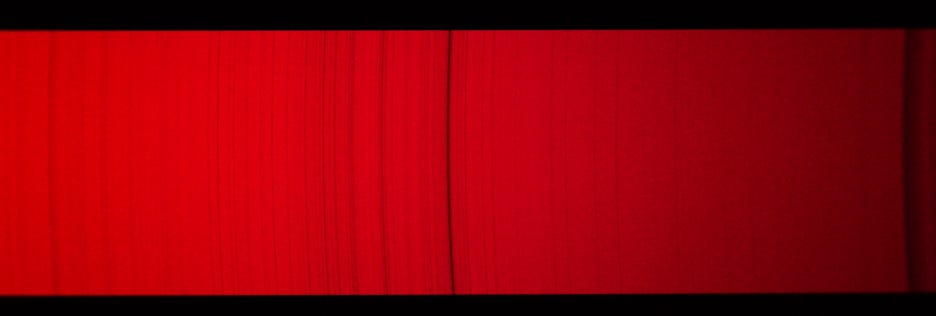
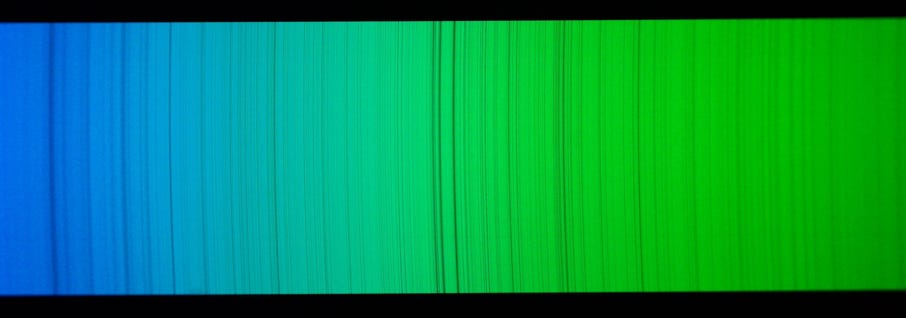
Part 5: Softwares
Sol'Ex is not limited to assembling hardware components such as optical components or 3D-printed parts: software is an essential component of the Sol'Ex project. The raw data captured must be carefully processed to be converted into usable images of the Sun.
The INTI software, developed by Valérie Desnoux, plays a central role in this process. It is one of the pillars of the Sol'Ex project, ensuring automated, rigorous, and reliable processing of observations. Its powerful complement, INTI Partner, allows for even more advanced data analysis and processing.
Both software programs can be downloaded free of charge from the following page:
http://valerie.desnoux.free.fr/inti/
You will also find detailed and regularly updated documentation.
For image acquisition, well-established fast capture software such as SharpCap, FireCapture or ASICap are ideal, ensuring a smooth image flow synchronized with the movement of the spectrum.
Part 6: Video channels, discussion lists, forums
A large part of the author's YouTube channel, Astro-Spectro, is dedicated to the Sol'Ex/Star'Ex project, with a large number of videos available on technique, tips, observation and results. Don't hesitate to visit it and subscribe, as it's updated regularly!
And don't hesitate to join the Sol'Ex group on Facebook, with hundreds of participants:
A must, the Sol'Ex groups.io discussion list (speak French and English) where you can ask all your questions, open to beginners and experienced observers alike. If you're looking for tips and tricks to share, this is the place. It's an absolute must if you want to know everything about the project:
Sol'Ex users very often publish their results on the excellent forum Astrosurf forum, here again do not hesitate to register (Astrosurf also hosts this site, many thanks to the Astrosurf team and especially Jean-Philippe Cazard who does a wonderful job):
Copyright (C) 2020-2025 Christian Buil
Web : www.astrosurf.com/buil